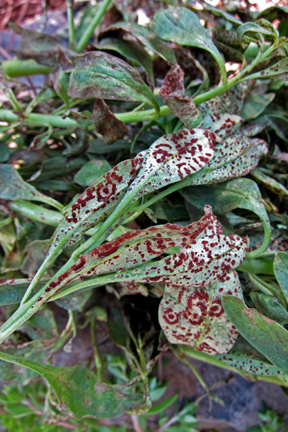





Q: A friend tells me that you might help identify this infestation on the back of my snapdragon leaves. It appeared as the plants were about to send up their flowering shoots and wilted them before most were able to flower.
A: You have an excellent example of snapdragon rust!
New infections and disease development are favored by cool nights and warm days combined with abundant dews, light rains, or irrigation. If temperatures remain between 45° and 65°F when plants are wet for six to eight hours, infection by air-or water-borne spores is almost certain.
A couple of sprays with chlorothalonil (click for sources) will control it on new leaves but diseased plants and the soil under your plants will harbor the spores for two years. Remove and destroy infected plants when seen and plant other cool season annuals in place of your snapdragons for the next couple of years.
Snapdragon Rust

Copyright © www.100flowers.win Botanic Garden All Rights Reserved